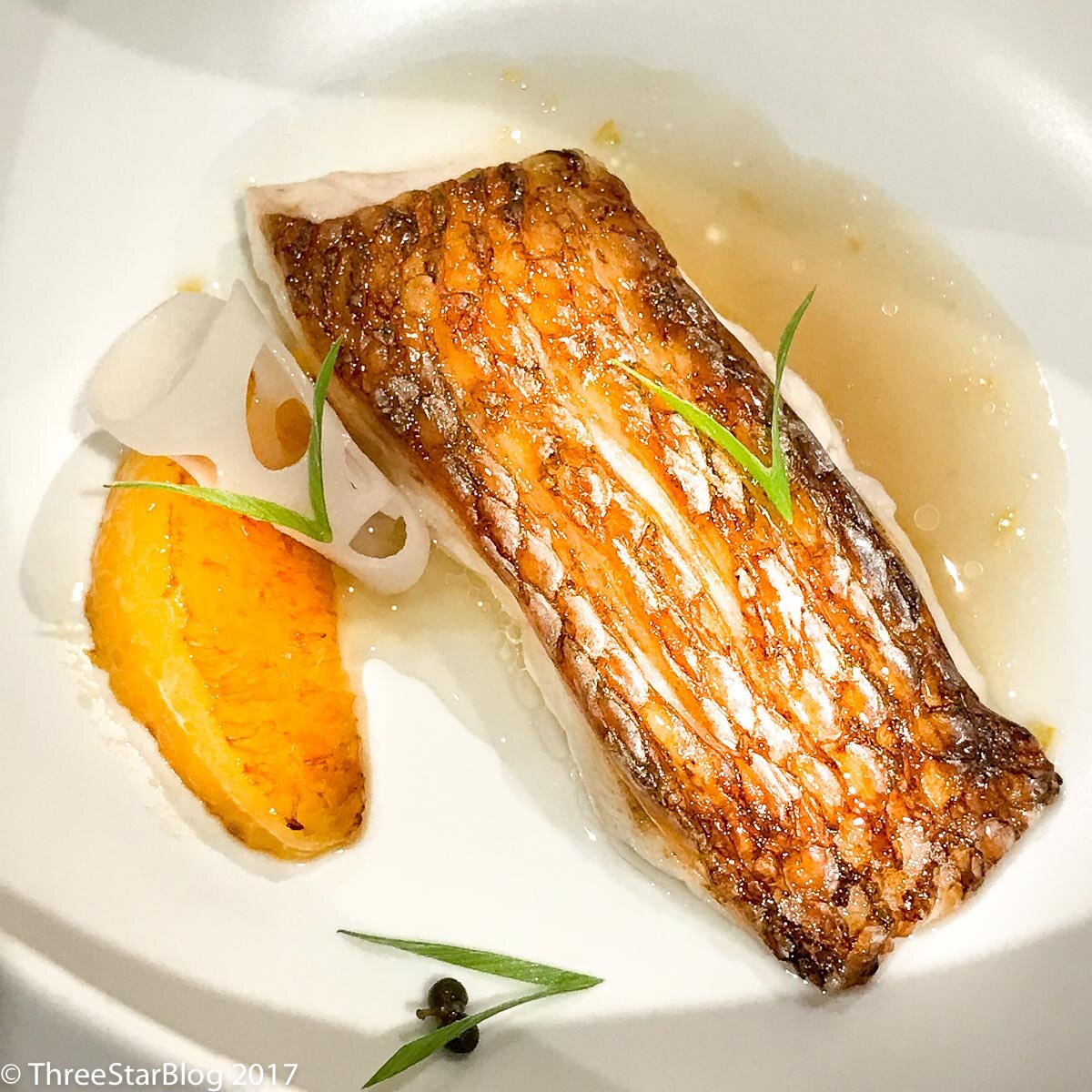SEOUL, SOUTH KOREA, JULY 2017
SERVICE: 6.5/10
FOOD: 8.5/10
PRICE PAID: $107PP (INCL. WATER, APERITIF, 2 GLASSES OF WINE, COFFEE- PRE-CHALLENGE)
VALUE/MONEY: 9.0/10
FINAL SCORE: 8.0/10
Operated by KwangJuYo Group, a maker of fine ceramics and traditional Korean liquor, Gaon’s website states a goal of presenting Korean culinary culture to the world. Head Chef Byung Jin-Chin takes that responsibility pretty seriously, saying: “As a chef, what I value most is a sense of responsibility about the ingredients.” He has taken years to study centuries of Korean cuisine, and tries to boil the best of it down into a simple idea of "transmitting “natural simplicity” to the diner.
Gaon received three Michelin stars in the inaugural 2017 Michelin guidebook, so was in its first year as a three-star at the time of my first visit.
As we enter, we are led down a labyrinthine hallway with museum-grade Korean antiquities, mosaics, and ceramics adorning walls and display cases. It’s a thoughtful setup that makes you feel as though you are passing through a time portal as you enter the main dining room.
The space is ethereal, light, and full of beautiful patterns and personality. The tables feel private even though the dining room is quite small, with only a few tables.
First up, a welcome aperitif of parsley, apple, lemon, salt served beautiful cocktail glass. The flavor is close to a wheatgrass smoothie. 8/10.
In a lovely, formal display, a huge grey-and-black leaf colored plate is brought over first (above). Then, an etched black stone plate is carried over with the course, and carefully moved piece-by-piece to our plates in front of us.
The first course, titled “the Five Flavors of Nature” (the five includes the aperitif), is beautiful to look at - 9/10 overall. Thoughtfully, they include a map (right) with the names and locations of the sources of the menu items. We are advised to eat right to left:
Tomato from Yangpyeon, presented skinned and somehow remains incredibly firm and fresh, bursting with freshness and richness, almost umami. 9/10
Uni with seaweed that is even richer and more umami than the first bite- fresh, and with the bright earthy tones that truly great sea urchin demonstrates. 9/10
Rice cake with beef from Eumseon in the middle of the country- the texture of the rice cake on the outside harmonizes with the beef perfectly - it’s almost impossible to distinguish where one component ends and the other begins, 9/10.
Lastly, the eggplant with a fish powder “salad” on top that is fried, which adds crunchiness to the smooth creamy eggplant. Extremely smooth finish to the dish. 9/10.
Next, one of the best bowls of soup I have yet had. From near the city of Nonsan, this corn soup is tongue-coatingly thick and very sweet, and served at the hot end of comfortable. Smooth and evenly puréed. Simple and delightful. 9/10.
Next, a small construction of Okhotsk snow crab from the waters between Korea and Russia; it’s so tender that it literally falls apart as it's picked up. The pale sticks are fresh Naju pear, a local delicacy, which adds a lovely acid note, and the entire dish is tossed in pine nut dressing. A very fresh taste overall, and the Jeju Mandarin orange pairing is subtle and a nice offset of sweet against the saltiness of the crab. A few errant chunks of shell do their best to murder my teeth but, happily, fail. 8/10.
Next, a royal chunk of abalone from Sacheon and sauce made with abalone and seaweed. Extremely firm, chewy, sauce is bright and salty. 8/10.
One of the most perfectly-cooked, freshest pieces of fish I have yet encountered on this adventure: Sea Perch from Jeju island. Paired with a ginger-glazed orange (on the left) also from Jeju all in a citrus reduction sauce, the flesh flakes apart easily. The acidic citrus pairs perfectly and is in balance with the oily, fatty fish, and the charred outside somehow tastes of marshmellow. Unbelievably perfect. 10/10
Next, a course of “Chestnut Honey,” which is is warm and pliable and tastes vaguely like Concord grapes. Pear on the outside, sweet and crunchy cabbage on the inside; a lovely balance of sweet, sour, and savory. 8/10.
Finally, on to the main course- “Striploin Beef” marinated in soy sauce with a huge kick of salt - the beef is rich, and extremely well-cooked (perhaps a touch overdone). As a side, Cabbage from Pyeongchang (a rural province in Northeast South Korea) and bamboo shoot marinated in anchovy sauce that tastes vaguely like… the wood shavings in a rabbit cage, but in a great way. Quite spicy too. 8/10 overall despite the oddly woody flavor to the side.
The last of the savory courses arrives next; a prototypical smorgasbord of small dishes titled “Radish Green/Summer Green.” Made with Kimpo rice milled just that day and paired with an “11-year-old aged soybean summer green soup,” (at right) this was your typical mishmash of fresh and fermented/preserved vegetables meant to quash any remaining hunger at the end of the dish. 7/10 overall.
Typical of Asian 3-stars, a subtle, not-too-terribly-sweet dessert comes last. In this case, a soymilk panna cotta is offered alongside some buckwheat tea and some sweetened red bean pastes. Light and refreshing. 8/10.
Last but not least, we are invited back for a short kitchen tour of the sparklingly clean Western-style kitchen, complete with pass.














































































































































































